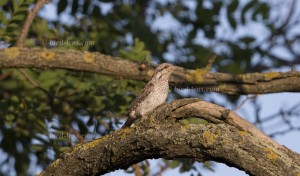 I am now back from a trip to Bulgaria for quite a while. As I wrote already in the Bee-eater-Blog, the main purpose was to photograph European Bee-eater (Merops apiaster). But as I mentioned in the recent blog, Bulgaria is full of wildlife which could be found relatively easy. As most of the mornings were spent with Bee-eaters or in a hide for Eurasian Golden Orioles (Oriolus oriolus), evening photo sessions quite often were spent roaming along country roads in the car and photographing any birds I encountered. I came up with pretty good results. There were many passerine birds present. I came across with Crested Lark (Galerida cristata), Eurasian Linnet (Carduelis cannabina), Black-headed Bunting (Emberiza melanocephala), Lesser Whitethroat (Sylvia curruca), Northern Wheatear (Oenanthe oenanthe), Lesser Grey Shrike (Lanius minor), Red-backed Shrike (Lanius collurio), Corn Bunting (Emberiza calandra) and others. But European Turtle-Dove (Streptopelia turtur) were also present in good numbers albeit a bit tricky to photograph.
I am now back from a trip to Bulgaria for quite a while. As I wrote already in the Bee-eater-Blog, the main purpose was to photograph European Bee-eater (Merops apiaster). But as I mentioned in the recent blog, Bulgaria is full of wildlife which could be found relatively easy. As most of the mornings were spent with Bee-eaters or in a hide for Eurasian Golden Orioles (Oriolus oriolus), evening photo sessions quite often were spent roaming along country roads in the car and photographing any birds I encountered. I came up with pretty good results. There were many passerine birds present. I came across with Crested Lark (Galerida cristata), Eurasian Linnet (Carduelis cannabina), Black-headed Bunting (Emberiza melanocephala), Lesser Whitethroat (Sylvia curruca), Northern Wheatear (Oenanthe oenanthe), Lesser Grey Shrike (Lanius minor), Red-backed Shrike (Lanius collurio), Corn Bunting (Emberiza calandra) and others. But European Turtle-Dove (Streptopelia turtur) were also present in good numbers albeit a bit tricky to photograph.
For the first time during the trip I saw Ground squirrels on the third evening. They are from the genus Speckled Ground Squirrel and also named Spotted Souslik (Spermophilus suslicus). Very cute and funny animals. They are quite shy animals for movements. If you stay in the car and do not move your lenses, they come back out of their holes and look quite curious. But if there are raptors in the air, than they are constantly under stress. One day they were constantly disturbed by Booted Eagle (Hieraaetus pennatus) what made photography tricky.
Eurasian Hoopoes (Upupa epops) were regulary seen in the many little villages. But they were quite shy and good images were still missing. While driving along the country roads I was really excited what I will see next. To my big surprise, on the secon evening of my trip I spotted remarkable black and white tipped crest moving in the grass just besides the road. It definetely was a Eurasian Hoopoe (Upupa epops). Now, I could make Hoopoe photographed from the car. Thus I used the car as my hide. I just was clever enough to think of a camouflage blanket for the opposite window. This was to darken the inside of the car and to prevent the Hoopoe be scared by a mowing shadow against a clear sky. Overall I spent probably 2 hours with the bird as it was disappearing in the grass, flying away and coming back again. It was one of the best photographic moments although the pictures are not exceptionally great.
Driving along the roads, I even spotted a European Roller (Coracias garrulus). It was quite shy and not as brave as the hoopoe. I assumed that the breeding tube was quite close. So the bird did not let me come close enough. Next day I set – up a temporary hide close to the place the roller was spotted. After a few hours of waiting I managed to photograph it. Then a friend, acting as a guide, showed me a little wood. This should be the place for a Eurasian Wryneck (Jynx torquilla). He switched-on the sound of the tape only once and you could hear the Wryneck already above me on a dead branch. This was the best situation, because afterwards with every repeat, this little woodpecker became more reluctant to show-up. So, after a while, we abandoned our efforts – also to give him relieve and not to disturb him.
Overall it was a great experience with nice memories and challenging photography what made it all more rewarding. Bulgaria is a nice place for nature lovers. Additionally it is a perfect destination for bird photographers – easily described as true wilderness. I am confident to go for the next trip for more Bee-eaters and hopefully Rollers as well.
To cope with the growing demand for top shots of the rarer species of the Palearctic Bird-Lens is keen to enrich the range of pictures of birds you can find in the western palearctic. Trips to remote places like in Bulgaria to capture images of rare birds of western palearctic were very successful. The images from the hide were shot during a workshop. The operator´s name of the workshop is Naturetravel. It is highly recommended. Most of the workshops run by Naturetravel – a tour operator based in Sofia – take place from April to July for periods up 2 weeks.
This nice image is only a first impression, what you will find in the gallery in the “Pictures Shop” very soon. Just give me a message, if I could serve you with an image needed before the new pictures are online.